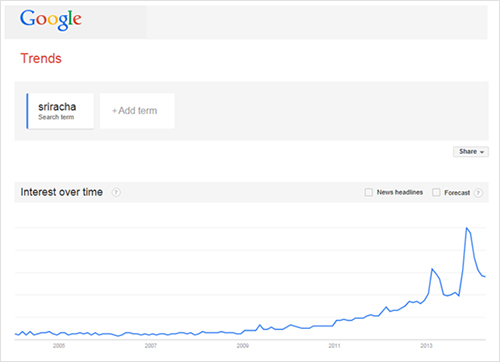That’s right.
The same folks who publish “the molecule of the week” and find humor in the periodic table have cracked the mainstream with storytelling techniques worthy of a big brand.
Before jumping to the tactic, it’s useful to rewind the tape to Nov. 27, 2013. That’s when the Los Angeles County court sided with the fine citizens of Irwindale and ordered Sriracha to cease operations until they could figure out a way to stop that dreadful odor emanating from the factory.

As I wrote back in 2012, here’s a brand that says the hell with branding and it works. In spite of snafu with its Irwindale factory, Sriracha has enjoyed an ever-expanding public profile. In the Google Trends chart below, you can how searches on [sriracha] started climbing roughly four years ago.

The Nov. 27 court order triggered the biggest spike on the chart. Regardless, Sriracha’s public profile continues to push up and to the right largely driven by popularity that transcends the foodies.
Which brings us back to the American Chemical Society.
The ACS PR smelled a PR opportunity – can’t resist a bad pun – to leverage Sriracha in reaching a mass audience. While they couldn’t predict when Sriracha would be in the news again, they recognized that the power of the Sriracha brand guaranteed a steady of stream of media coverage. And by explaining in plain language the science behind the sauce and the reaction from one’s taste buds in a video, the ACS stood to insert its voice into future Sriracha stories.
YouTube / Reactions – via Iframely
OK, that’s not exactly true.
The video created by the ACS delivers this ditty on the chemistry behind Sriracha:
“ Inside the red chilies is a group of molecules called capsaicinoids. Within this Group, two molecules pack up to 95 percent of the blistering punch, capsaicin and dihyrdocapsaicin. These two molecules trigger the TRPV1 receptor protein in the mouth which usually responds to scorching temperatures above 109 degrees Fahrenheit; thus, causing the spicy hot sensation. Then the body responds to the capsaicins burned by releasing a pain-killing endorphin rush kind of like what a jogger experiences after a long run.”
While not exactly language for the technically challenged, the storytelling techniques in the video and underlying PR strategy worked. Numerous media properties including NPR, The Atlantic and USA Today published stories on the video. Plus, the evergreen quality of the video means continued exposure for the ACS as we saw this month with Sriracha once again in the media for that smelly Irwindale factor.
One final comment on the ACS video –
After explaining how the chemical makeup preserves Sriracha even without refrigeration, the video calls out this information as useless:
“ … because as far as we understand, it’s impossible for a bottle of Sriracha to go bad without eating it all because again, it goes good on absolutely everything.”
While no one enjoys a language tug of war more than I do, the ACS should probably steer clear of double entendres.
Still, levity in storytelling does make for a potent formula.





